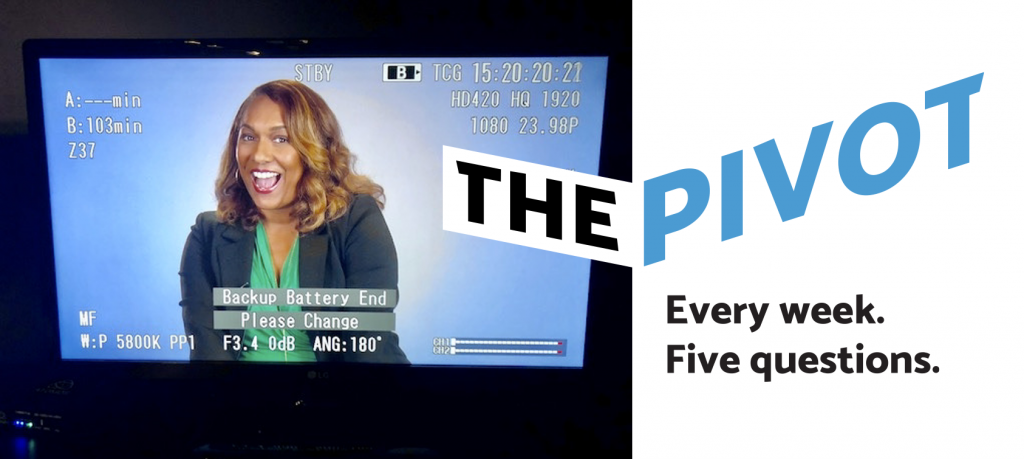
Dr. Dana Rice works to prevent the wounds of mass incarceration.

What’s your role in public health?
I’m the Gillings School’s new assistant dean of master’s degree programs and an assistant professor in the Public Health Leadership Program. I’m starting my fourth year here, and I currently teach the integrated learning experience course for Master of Public Health students in leadership and practice, health policy and management, nutrition, and the nutrition/Registered Dietitian programs. I also teach two elective courses on mass incarceration/mass criminalization and public health. (This photo is from when I recorded content for an online Master of Public Health course!)

Can you describe your focus area in one sentence?
My focus is on understanding mass incarceration and its impact on public health.
I’m trying to understand the ways in which the criminal legal system in the United States disproportionately impacts communities of color, which ultimately affects their health outcomes. It comes down to recognizing that our current system was built on structural and institutional racism and imagining an alternative approach to achieving justice, safety and well-being. The public health prevention framework includes primary/secondary/tertiary prevention activities. This model serves as a framework for how I think about my work. How do we keep people from entering the system, keep them healthy while they’re in the system, and help them stay well and free when they emerge?
I think about the system as having multiple starting points, beginning with what I frame as mass criminalization. Our society has been structured in a way that has caused people of certain racial and ethnic backgrounds, as well as other social identities, to have more frequent contact with the criminal legal system and to receive a more severe response from those actors. This engagement disrupts community cohesiveness, among other things — but more importantly, is not effective at creating safe and healthy communities. Couple that fact with all of the other social and economic challenges these communities experience — like poverty and poor housing — and that’s a starting point for understanding how the system and our policies impact health outcomes. Communities that are suffering due to disinvestment in social support systems are the same communities that tend to be overpoliced and underprotected, neither of which creates an environment for health and wellness.
Then, when you think about moving along the continuum, people enter into the formal criminal legal system through jails and prison. We know that many folks already have poor health status upon entry, and their term of incarceration does nothing to improve their health status or offer meaningful and long lasting rehabilitation. Our system is in no way an evidence-based practice for improving health and wellness or public safety. So, some of my work is about understanding the nuances of correctional institutions and creating system-wide transformation through initiatives that improve the conditions of confinement. Some examples are identifying people’s health challenges when they come into a jail/prison and providing a better environment for the more than 2 million people currently incarcerated. We must ensure that people are not worse off when they leave than when they went in.
The third stage is re-entry into society. Our system does very little to reconnect people with their home community, even though we know that 92% of people are released and go right back where they came from — typically to the same communities that are suffering. Public health interventions could be applied to help these people stay safe, connect with health services and find pathways to avoid returning to the system.

What brought you to public health?
Honestly, I fell into public health. I was working in a research laboratory as a biologist for a large pharma company. I felt challenged by pipetting all day instead of talking to people and forming a community. I decided to apply to the master’s program in kinesiology at the University of Michigan and I was actually walking over to submit my completed application when I cut through the school of public health. They had student research posters on the walls about HIV/STD prevention and social justice and community-oriented health equity work, and that was my introduction to a field I’d never known about.
I ripped up my application, enrolled in their summer session for epidemiology and, ultimately, decided to go into public health. I enrolled in a master’s degree program and found new job in local public health as an environmentalist and got my boots-on-the-ground training while applying what I learned in class directly to my work every day.

How have you pivoted in response to the coronavirus pandemic?
The change in my research focus was dramatic but expected, given not only the pandemic but the concurrent conversations around racism in this country. All of a sudden, the conversation of what to do about mass incarceration was in the public space in a way it had never been before. The general public could see with how people who are incarcerated were being impacted by the virus and the national attention elevated the work I was already doing. While it was disheartening to see what was happening behind bars, my colleagues and I were like, “Finally, people are getting it.”
We’ve dealt with two responses: Some folks are ready to have the conversation about transforming the system, while other people aren’t 100% comfortable what meaningful change would really take. This tension is evidenced by the fact that we’re still seeing disproportionate numbers of COVID-19 cases in correctional institutions and there’s still a debate over decarceration efforts or when to vaccinate both people behind bars and the staff who work there.
A possible silver lining of this pandemic is that it’s forced us to limit the number of people who are incarcerated, even though in some cases it has been temporary. This may provide an opportunity to show that we can change the criminal legal system; the right thing for public health is also the right approach to fixing what’s broken. The last year has basically been an informal pilot study, so now I’m bringing the resulting evidence to bear to support sustaining the decisions made during the pandemic.

Who are you when you’re at home?
I’m a wife and a mom! I have two sons: a 22-year-old in college, playing football, and a 12-year-old. I’m a foodie and I collect cookbooks. I love to experiment with recipes, with the caveat that I’m not a baker. I make a mean gumbo — it’s my own recipe combined from multiple influences, including family — and, as a huge brunch fan, I do an amazing baked French toast with praline topping. I was also inspired by my great-grandmother to master quiche-making.
I was born in D.C. and spent time in New York and Philly before going to college in Georgia at Clark-Atlanta University, a Historically Black College and University (HBCU). After college, I moved to Michigan to be closer to family.
I’m very adventurous and outdoorsy but also appreciate a long beach day. I’ll do almost anything as long as I don’t have to jump out of an airplane! I try to walk almost every day; I love a hike; and I’ve gone scuba, whitewater rafting, deep sea fishing, jet skiing and zip lining. I once did a local Dancing with the Stars event in Detroit, actually! My husband is retired from the NFL. He was asked to participate, and, when he declined, I went in his place. I danced the tango to Sweet Dreams by the Eurythmics!
